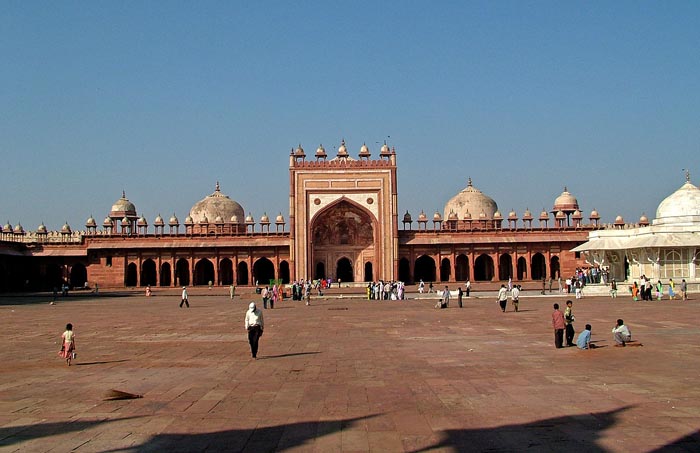Jama Masjid Agra

Information on Jama Masjid (Agra, Uttar Pradesh) - History & Architecture
Jama Masjid is a popular mosque in Agra which is situated in the opposite side of Agra Fort. Jama Masjid is also known as 'Jami Masjid' or 'Friday Mosque' and is considered as one of the biggest Mosques in Uttar Pradesh. Jama Masjid was created by famous Mughal emperor Shahjahan in the year 1648 and was devoted to his daughter named Jahanara Begum.
Jama Masjid Agra Religious Significance
Jama Masjid is highly religious place for Muslim pilgrims. They regularly throw prayer in this masjid. The prayer usually occur in two ends one is during the day and the other one is during the approaches of night. It is believed that regular prayers at Jama Masjid remove the evil from human. There are various religious festivals of Muslim, and Jama Masjid celebrates some of them in elegant way. The sacred month of Muslim calendar, Ramadan is celebrated in Jama Masjid. It organises mealtime, banquet after sunset and also after 'Maghrib', which is termed as the fourth essential prayer on that day. There is another celebration in Ramadan namely Suhoor which include a meal before dawn. Jama Masjid also permits poor people of Muslim society to have free food at the beginning of the Ramadan day.
Furthermore, Id-ul-Fitr and Id-ul-Zoha also celebrated in this mosque. The regular prayers and compulsory prayers such as Jamuah are organised in this mosque. Jamuah the Friday prayer, is organised in Jama Masjid which is an obligation for any mature Muslim to perform. Moreover, there is also another prayer named Salat which is required to be held in the mosque. This prayer uses Arabic language in order to obtain bless from god. As number of prayers are held in Jama Masjid through Eid festival, the vision of prayer gallery become revitalised. This historic place come alive and ornamented with lights on the day before of Eid-ul-Fitr. With the end of tough month of Ramadan, Mulsim people express joy and hug each other on this festive occasion of Eid.
Jama Masjid Agra Mythology
According to Muslim mythology, there was an expansive and octagonal Chowk in Jama Masjid which existed between the mosque and Delhi Gate. However, between 1871 to 1873, the structure was demolished for obtaining more space in order to install railway track in Agra Fort Railway Station. One require to enter into the mosque from eastern side. The prayer compartment of the mosque possesses a frontage with extensive curved structure which is decorated with slim towers, alternated with cubicles.
Jama Masjid have three domes, capping the sanctuary. Every domes possesses inverted lotus structure with crisscross courses of white marble, swapped by extensive bands of red stone. There is Persian caption in white marble which is decorated with black stone on the arcade of central entrance in praise of king Shahjahan and princess Jahanara. Muslim mythology also depicts that it has taken about six years and 5000 labours in order to complete this mosque.
Jama Masjid Agra Architectural Significance
Jama Masjid has simple architectural design which is created from red sandstone with white marble decoration. The wall and ceiling of the mosque is painted with blue colour. The mosque is edged by two large galleries which was created in such a way that highlights it a sacred place. The massive central yard of Jama Masjid act as a harbour for prayer and meditation for devotees.
Jama Masjid stands on a high altitude which is reached by stairs and five curved gateways. The mosque possesses well balanced structures which is enclosed by monasteries on three sides, where the prayer compartment is on the western side. People can find marvellous panels of decorated work in Jama Masjid which is comparable to Taj Mahal.